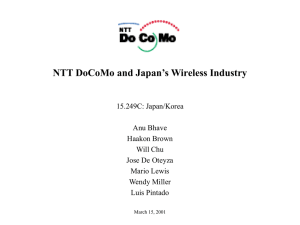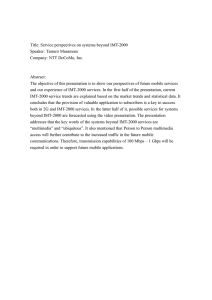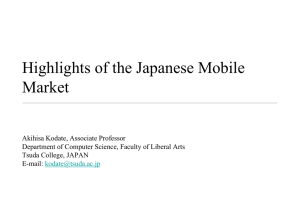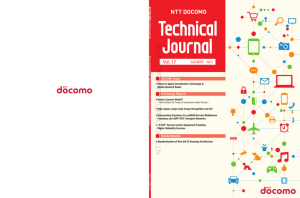Service Perspectives on systems beyond IMT-2000 Outline z
advertisement
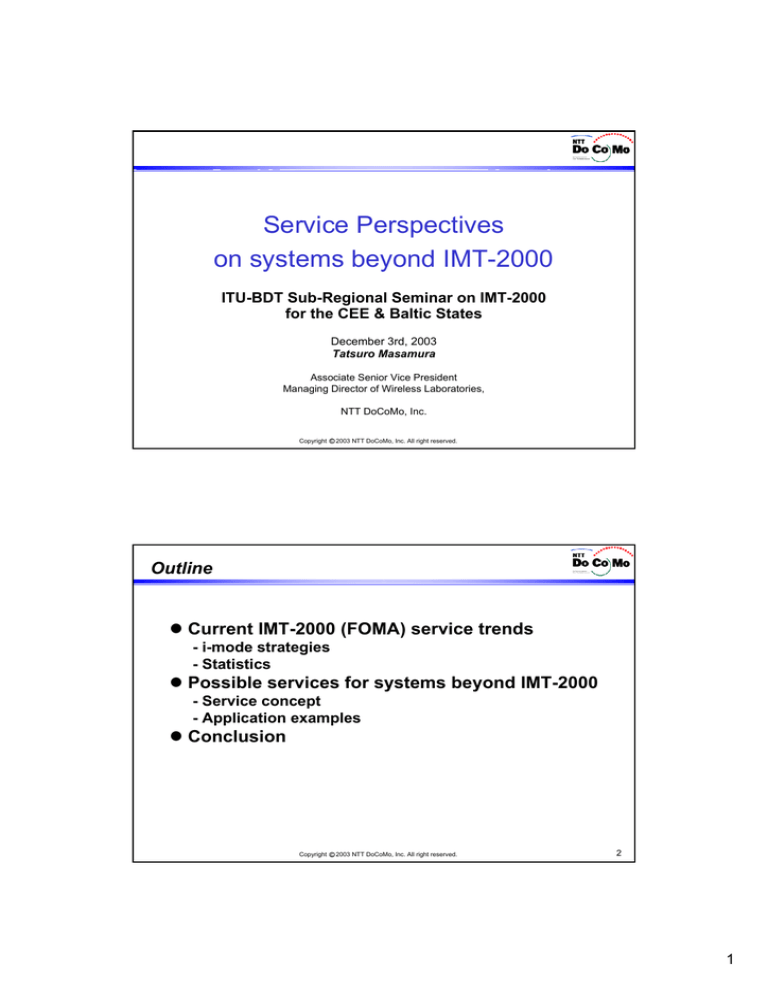
Service Perspectives on systems beyond IMT-2000 ITU-BDT Sub-Regional Seminar on IMT-2000 for the CEE & Baltic States December 3rd, 2003 Tatsuro Masamura Associate Senior Vice President Managing Director of Wireless Laboratories, NTT DoCoMo, Inc. Copyright c 2003 NTT DoCoMo, Inc. All right reserved. 1 Outline z Current IMT-2000 (FOMA) service trends - i-mode strategies - Statistics z Possible services for systems beyond IMT-2000 - Service concept - Application examples z Conclusion Copyright c 2003 NTT DoCoMo, Inc. All right reserved. 2 1 Evolution scenario towards Beyond IMT-2000 ’80S ’90S Initial stage Voice Growth stage Mature stage Expansion stage Voice + Low speed data (~64kbps) 1st Generation 2nd Generation Analog Cellular Digital Cellular NTT High Cap, AMPS, TACS, NMT 2000~ Voice + High speed data (~384kbps, 2Mbps) Super high speed 3rd Generation IMTIMT-2000 Systems beyond IMT-2000 W-CDMA, CDMA2000, TD-SCDMA PDC, GSM, IS-95, PHS NTT DoCoMo’ DoCoMo’s Scenario in Japan 2000/03 2001/03 2002/03 2004/03 Network Construction Over 99% population coverage Introduction of Commercial Service From Tokyo Metropolitan to Nationwide Service area: As of March 03 By March 04 3 Copyright c 2003 NTT DoCoMo, Inc. All right reserved. IMT-2000 (FOMA) handsets (as of Nov. 2003) Standard type Visual type Data-card type PDA type N2051, F2051 P2102V, N2102V F2402 SH2101V SOHO type Freedom Of Mobile multimedia Access “F” also stands for Frontier, Flexibility and Future. F2102V Copyright c 2003 NTT DoCoMo, Inc. All right reserved. F2611 4 2 Current IMT-2000 (FOMA) services i-mode z z z z Up to 384kbps downlink high-speed access Still pictures and music can be attached to i-mode mail Up to 5,000 characters for outgoing e-mail i-appli content is available z Video clipping service using i-mode <i-motion> Videophone M-stage Service z Comfortable motion picture transmission using 64K digital transmission z z DoCoMo’s music distribution service <M-stage music> DoCoMo’s video distribution service <M-stage visual> z DoCoMo’s Live distribution service <V-Live> High-speed Data Communication Multi-access Voice Communication z Up to 384kbps downlink and 64kbps uplink packet transmission z 64kbps digital communication z Data can be sent over the packet-switched network while speaking on the phone z Voice quality as good as fixed line services z Dual mode (FOMA/PDC) service for increased convenience (a single phone number is used for both services) International roaming services (expected to be introduced) http://www.nttdocomo.co.jp/english/p_s/imode/index.html 5 Copyright c 2003 NTT DoCoMo, Inc. All right reserved. Strategy for i-mode evolution for 2G & 3G Applications are a key to success! Evolution of Java FOMA External Colored Extension - Music Terminals LCD and Network Intranet Packages Evolution of Contents - Game i-mode launch - Home page - e-mail Feb. 1999 Evolution Groupware Spring 2000 - Video Conference (SSL) of- Security Users Winter 2000 - QR code Reader - Video - Schedule Management - Car navigation Linkage - Work flow Management - Playstation Linkage - Electronic Bulletin - Agent function Board System - Electronic Conference - File Sharing Fall 1999 - Fingerprint Recognition Packets/day (2G & 3G) Synchronization of Video Rich the three evolutions Camera Camera Winter 2001 Copyright c 2003 NTT DoCoMo, Inc. All right reserved. (Visual, High Speed) Intranet Web Access - TV phone Portal Link - Mobile TV - Interactive TV Spring 2002 Spring 2003 6 3 Positive value chain for multimedia data services Strategy for multimedia data services: Need to establish “Positive value chain” Users 1) Operators Establish mobile infrastructures with “value” - for both the Network and Terminals (we established the 2G packet network well in advance of i-mode service introduction) Provide attractive contents Pay for use 2) Content providers Provide content with “value” (content providers can establish business easily by exploiting the operator-provided infrastructure ) Contents Providers Operators 3) Users Provide good Infrastructure Spend money on content and communication (users play a role in defining contents and drive the demand for more sophisticated contents) Sustain the “value chain” steps 1), 2) and 3) Operator plays a role in managing the “positive value chain” 7 Copyright c 2003 NTT DoCoMo, Inc. All right reserved. i-mode packet usage statistics - Number of packets/day increased for IMT-2000 38,648 34,883 33,493 35,000 2,000 1,800 28,000 1,600 1,400 21,000 1,200 1,000 FOMA 14,000 800 600 7,000 400 PDC Number of packets per day Number of ii--mode subscribers (thousands) 37,758 36,209 200 2002/4 5 6 7 8 9 10 11 12 2003/1 2 Copyright c 2003 NTT DoCoMo, Inc. All right reserved. 3 4 5 6 8 4 Average Revenue Per User (ARPU) - Packet data services boosted up ARPU*1 for IMT-2000 FY ending on Mar.31, 2004 9,610 (Yen/month/subscriber) PDC i-mode ARPU 8,120 1,750 PDC MOU 168 minutes 6,370 PDC PDC Voice 7,740 ARPU+ FOMA Packet ARPU FOMA Voice ARPU+ 2,690 5,050 +Inclusive of circuit switched data communication FOMA MOU*2 109 minutes PDC MOU 162 minutes FOMA 8,040 3,250 1,900 6,140 6,360 PDC FOMA FOMA MOU 171 minutes FY2003/1Q FY2002 (Full year) *1 ARPU: Average Revenue Per User (yen/month/subscriber) *2 MOU: Monthly minutes Of Use (minutes/month) Copyright c 2003 NTT DoCoMo, Inc. All right reserved. 9 Conclusions on IMT-2000 service trends Observations: - Services are shifting from Speech to Multimedia data Attractive applications/services are a key to success Number of packet-usage per user increased due to applications Packet tariff was cut Our users were encouraged to enjoy more applications, Consequently, operator revenue increased. Strategy for multimedia data services: - Establish “Positive value chain”, Operators should: - build an attractive mobile infrastructure and - manage the “positive value chain” Copyright c 2003 NTT DoCoMo, Inc. All right reserved. 10 5 Service concept for systems beyond IMT-2000 Multimedia & Ubiquitous Virtual presence, HiHi-Fi H:Human Human H: M: Machine M: Machine H to H e-mail Voice MM mail Net browsing i-mode GPS ITS Mobile network TeleTele-metering Remote operation MMD M to M H to M Automatic control Sensors Rich content Invisible support 11 Copyright c 2003 NTT DoCoMo, Inc. All right reserved. 2 factors driving traffic (systems beyond IMT-2000) Increase due to multimedia applications Aggregative increase due to ubiquitous terminals (voice vs. multimedia) (all-in-one vs. ubiquitous & dedicated) (Mil.) Very costcost-effective networking is a must! 500 Traffic 70-80% 400 Terminals Multimedia 300 Ubiquitous appliances e.g. networked appliances, tags and sensors will be present in a Ubiquitous computing environment Business models with charge settings based on terminal & service varieties 90-80% 200 20% Population Voice 30-20% 80% 60% 100 All-in-one type 40% 2000 2005 2010 Copyright c 2003 NTT DoCoMo, Inc. All right reserved. 2000 2005 10-20% 2010 12 6 Application example (1) Mobile Remote Learning Systems (High data rate and low latency) - Scene: Network community school - Enablers and requirements: Mobile Remote Learning System 1) PC hands: Bio-info sensor: 1 - 100 Mbps, 50 msec 2) Remote learning system: Ambient communication: 50 Mbps – 1 Gbps, 50-100 msec - Resulting overall requirement: Data rate: 1 Gbps, Latency: 50 ms Copyright c 2003 NTT DoCoMo, Inc. All right reserved. 13 Application example (2) E-commerce and Delivery Systems (High security, medium data rate ) - Scene: a shop in a town - Enablers and requirements: E-Commerce & Delivering System 1) Mobile wireless wallet: Secure communication: < 1 kbps, <1 sec 2) Merchandise delivery system: Data base access: stock check and high-quality image catalog access < 100 Mbps, < 1 sec - Resulting overall requirement: Data rate: < 100 Mbps, Latency: < 1 sec Copyright c 2003 NTT DoCoMo, Inc. All right reserved. 14 7 Application example (3) Mobile Town Monitoring Systems (High data rate, huge number of terminals) - Scene: Urban town, Individual terminal linking with a town monitoring system - Enablers and requirements: Mobile Town Monitoring System 1) Embedded mobile terminal: Town monitor: < 1 kbps, < 1 sec. Video phone: < 1Mbps, 50 – 100 msec File transfer: (3D video file) < 1 – 45 Mbps, < 2 sec. * Terminal density: 2 – 3 units/ 10 m2 - Overall requirement: Data rate: < 45 Mbps, Latency: 50 msec. Copyright c 2003 NTT DoCoMo, Inc. All right reserved. 15 Application example (4) Mobile Medical Examination and Medical Record Access Systems (High data rate, robust and reliable connection) - Scene: Remote area while driving in car - Enablers and requirements: Mobile Medical Examination System 1) 3-D video communication: 1 – 45 Mbps, < 100 msec 2) Hologram video communication: 500 Mbps – 30 Gbps, 50 msec 3) Bio info. communication: 1 Mbps – 100 Mbps, 50 msec. 4) Medical database access: a single CT scan image (chest region) data : 8 Mbps, <1 sec. - Resulting overall requirement: Data Rate: 500 Mbps – 30 Gbps, Latency: 50 msec. Copyright c 2003 NTT DoCoMo, Inc. All right reserved. 16 8 Application example (5) Mobile Virtual Laboratory (Variable data rates) - Scene: Botanical expedition to a tropical rainforest outside Japan - Enablers and requirements: Mobile Virtual laboratory 1) 3D image file transfer: 1 Mbps – 45 Mbps, < 2 sec 2) Video phone: < 1 Mbps, 1 sec 3) Data base access: < 10 Mbps, 1 sec - Resulting overall requirement: Data rate: < 50 Mbps, Latency: < 1 sec. Copyright c 2003 NTT DoCoMo, Inc. All right reserved. 17 Application example (6) One-stop Boarding System (Secure connection) - Scene: Simultaneous airport check-in and passport control at an airport Mobile network, using personal data inside a single, versatile terminal - Enablers and requirements: One-Stop Boarding System All-in-one versatile terminal: < 1 Mbps, 50 – 100 msec * Terminal density: 2 – 3 units / 10m2 - Overall requirement: Data rate: < 5 Mbps, Latency: 50 – 100 msec Copyright c 2003 NTT DoCoMo, Inc. All right reserved. 18 9 Application example (7) Bus-on-demand Systems (Low data rates, huge number of terminals) - Scene: Public transportation access - Enablers and requirements: Bus-On-Demand System Bus Operation Database access: <100 kbps, < 1 sec * Terminal density: > 2,000 units/km2 - Overall requirement: Data rate: < 10 Mbps, Latency: < 1 sec 19 Copyright c 2003 NTT DoCoMo, Inc. All right reserved. Potential services and their requirements IMT-2000 Service categories Existing services Examples Systems beyond IMT-2000 Beyond the systems beyond Major requirements of network infrastructure E2E transmission delay Terminal / Connection delay density – ~ 64 Kb/s 100 ms/ < 2 s 64 Kb/s~1Mb/s 50ms~100ms/ < 2 s – ~1 Kb/s – < 1 s* / < 2 s ~1Mb/s – (* : Delay between server and – end terminal) ~10 Mb/s – – 1Mb/s~45 Mb/s 100 ms / < 2 s Bit rate Voice Video phone IM, e-mail Video mail Packet mobile broadcasting Intranet access 3-D video communication Reality Ambient communication 50Mb/s~1Gb/s 50ms~100ms/ < 2 s – 500Mb/s~30Gb/s 100 ms /less than 2 s – Bioinformation Hologram video communication The five Peripheral nerve info senses Brain – brain Remote control ~10Mb/s 50 ms~/50 ms~ Tele-existence ~10Mb/s Control of home appliances – 1ms~50ms /10ms~50ms –/– Ubiquitous directory service – –/– Virtual alter ego Ubiquitous 1Mb/s~100Mb/s ~2Tb/s ≒ 50 ms / ≒ 50 ms Copyright c 2003 NTT DoCoMo, Inc. All right reserved. quasi always -on – – – ~20 / 10m2 ~20 / 10m2 ~1000 / 10m2 20 10 Trend in bit rates of public data access 1G Data speed [bps] Wireless world Systems beyond 100M FTTH ss ce ac 10M 1M of a ta cd i l b pu d e CATV/ xDSL fix d en Tr ISDN 100k 10k Wired world Data rates for wireless access have always been 5 years behind that of wired access VDSL High speed data of IMT-2000 IMT-2000 PHS Voice band modern PDC d en Tr 1k 1995 1990 IMT-2000 2000 m of ile ob pu ic bl t da a ss ce ac 100M to 1G (in 2010) is a reasonable perspective from user viewpoints, not operators’ convenience 2010 2005 21 Copyright c 2003 NTT DoCoMo, Inc. All right reserved. DoCoMo’s views and scenario Data speed [bps] 1G -A breakthrough in Radio Beyond Interfaces is needed, - Longer time to migrate from IMT-2000” 2000” to “systems beyond 100M “IMTPeak IMTIMT-2000” 2000” is forecasted, Approx.14M - InterInter-working would be a 10M solution average 3G & 3.5G MAX sepc. 2M 1M 384k Breakthrough 100k 2G & 2.5G 2.4k Breakthrough 2010 2M Need New Mobile Access to accommodate HSDPA traffic increase 2005 in Urban area Need deployment traffic increase PDC Packet PDC 3rdG band (2GHz) 2ndG band (1.9GHz PHS) 2ndG band (800MHz PDC) PDC 92 NMA 100M – 1G to accommodate 32k PHS 28.8k 9.6k PHS 10k 1k 64k W-CDMA 3G 95 00 05 Copyright c 2003 NTT DoCoMo, Inc. All right reserved. 10 22 11 Conclusions on services of systems beyond “Multimedia” Above and “Ubiquitous” are key words, two factors will drive traffic growth, Transmission capabilities from 100 Mbps to 1 Gbps required to support applications. Copyright c 2003 NTT DoCoMo, Inc. All right reserved. 23 Challenges for systems beyond IMT-2000 12
